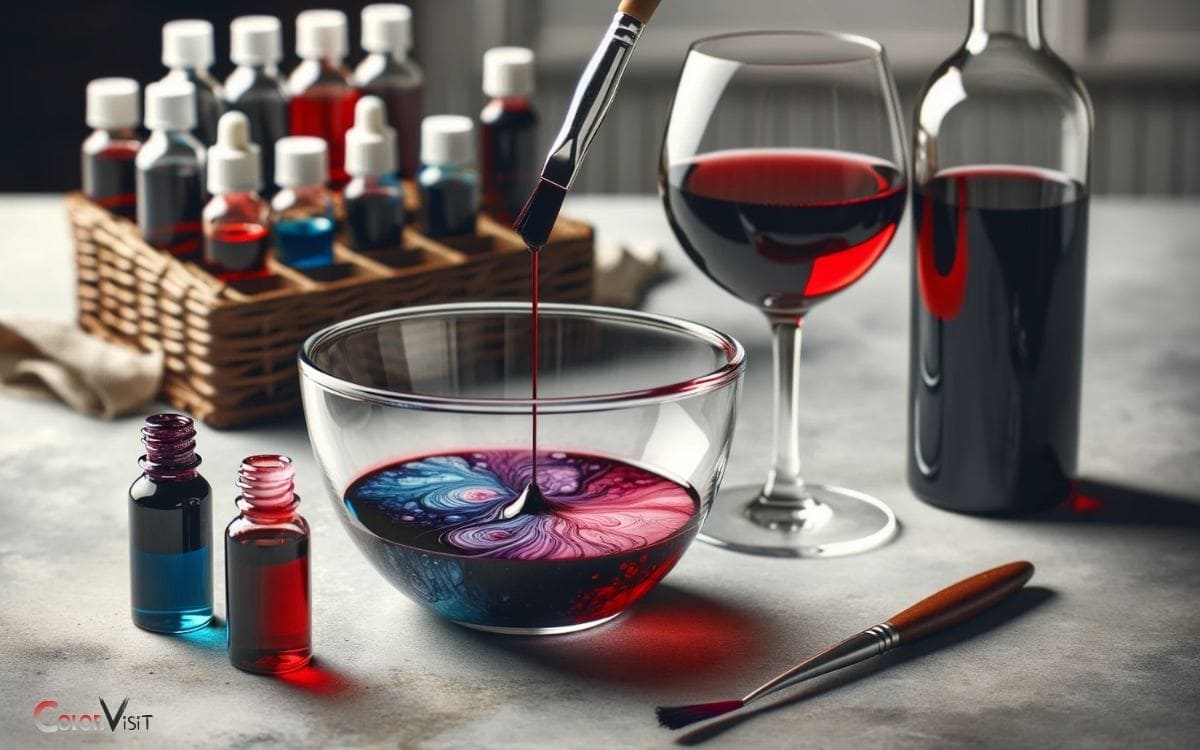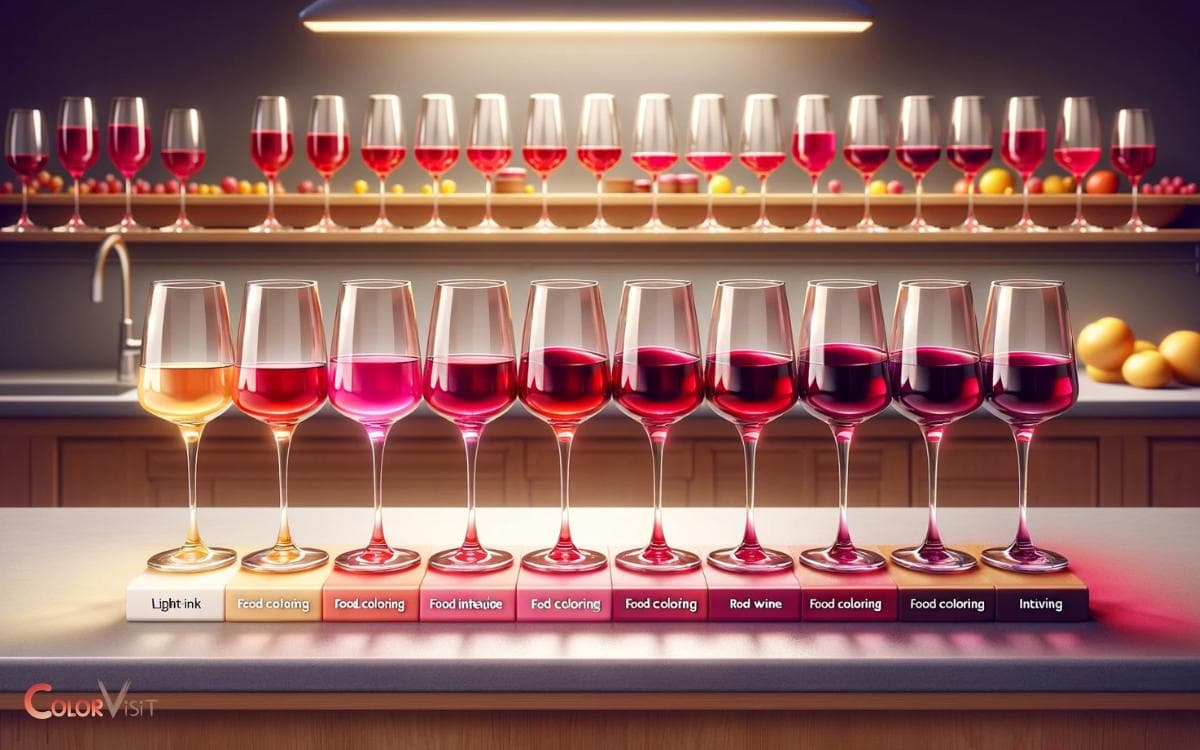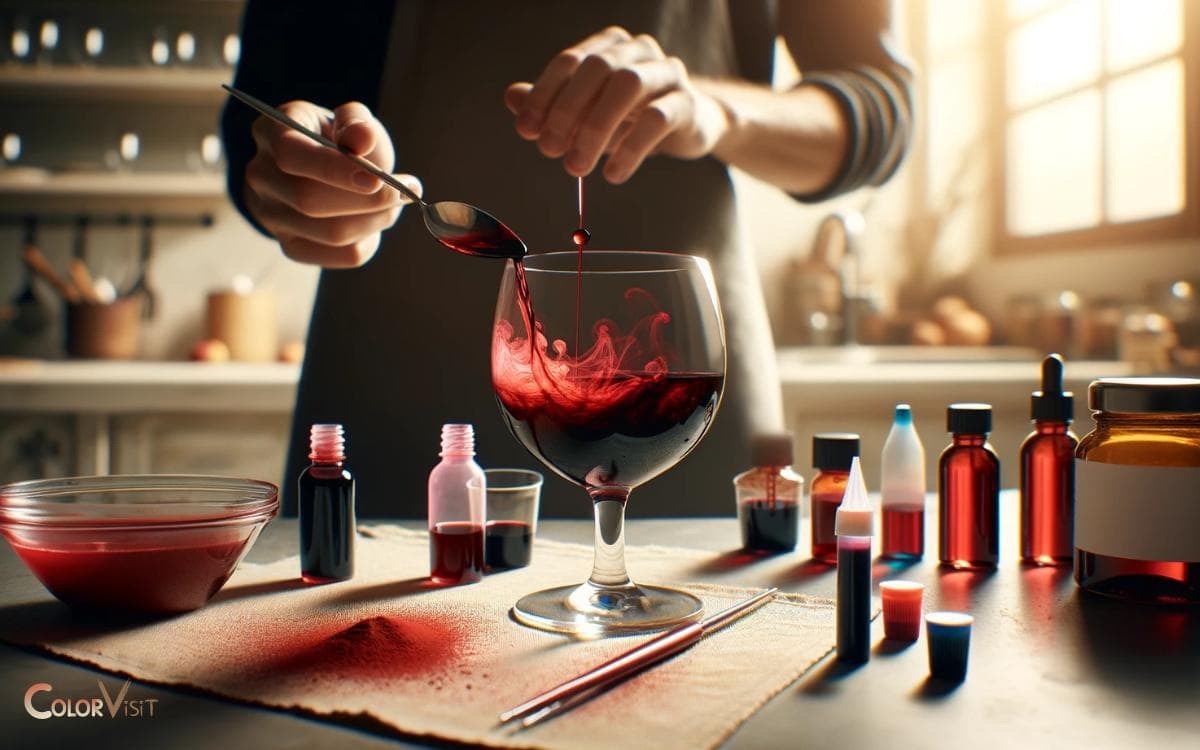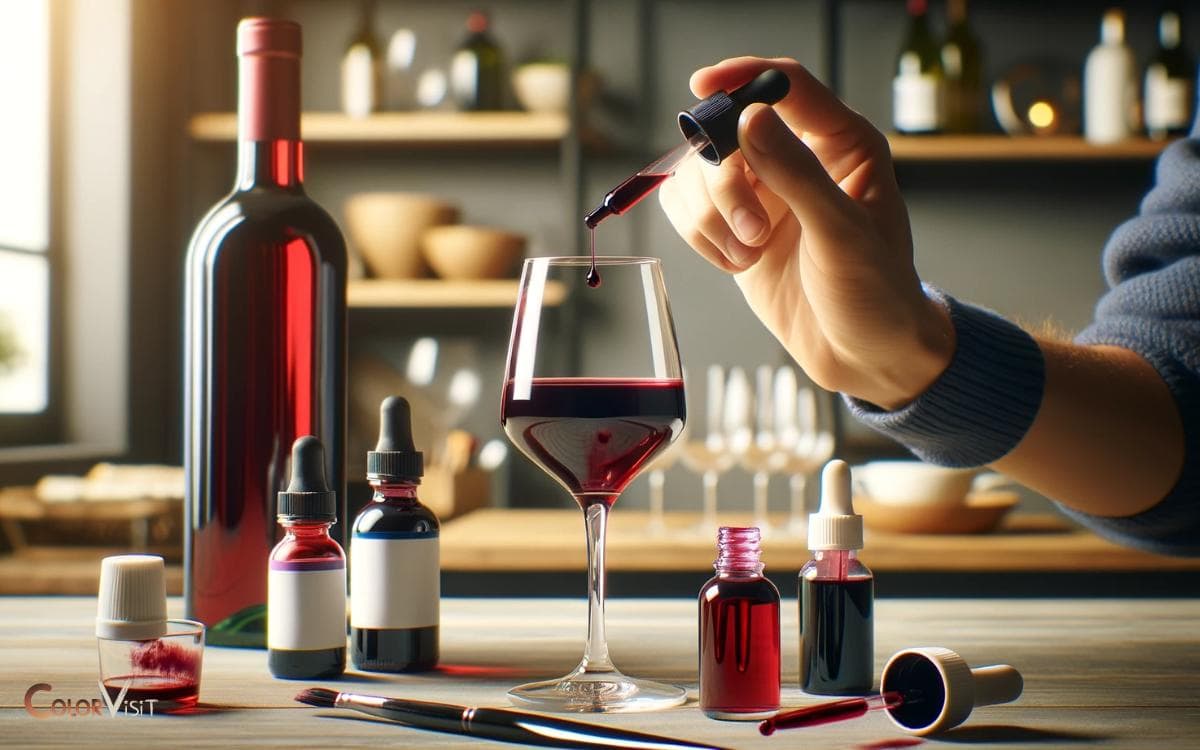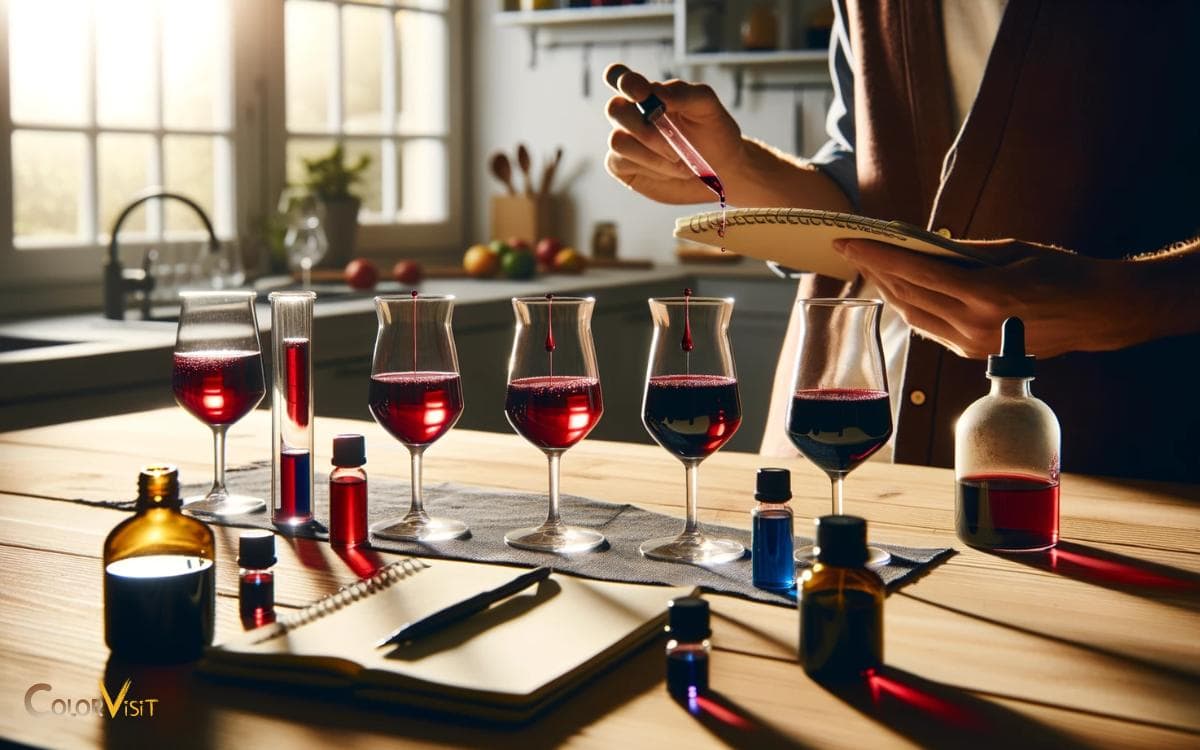How to Make Red Wine Color with Food Coloring? 6 Steps!
To make red wine color with food coloring, start by selecting a high-quality red food dye. Combine a small drop of blue food coloring with your red dye to achieve a deep red wine hue.
The process of creating a red wine color with food coloring involves the careful blending of colors to achieve the desired hue:
Crafting the perfect red wine color with food coloring can add a personalized touch to your beverages, making them as visually appealing as they are delightful to taste.
Key Takeaway
Step 1: Understanding the Basics of Food Coloring
Understanding the basics of food coloring involves comprehending the chemical composition and color properties of the dyes used to alter the appearance of food and beverages.
- Food colorants are typically classified as natural or synthetic, with each category offering distinct advantages in terms of stability, intensity, and regulatory approval.
- Natural colorants are derived from plant, animal, or mineral sources, utilizing compounds such as anthocyanins, carotenoids, and chlorophyll.
- Conversely, synthetic colorants are often derived from petroleum-based chemicals and are meticulously engineered to achieve specific hues and levels of solubility.
- The selection of food coloring is crucial in achieving the desired result, as it impacts not only the visual appeal but also the taste and overall consumer perception.
Step 2: Selecting the Right Food Coloring
When selecting the right food coloring for red wine, it’s important to consider the choice between natural and artificial colors, as well as the intensity options available.
Natural colors may provide a more authentic hue, while artificial colors offer a wider range of intensities.
Additionally, it’s crucial to ensure that the food coloring chosen is compatible with the specific type of wine being used.
Natural Vs. Artificial Colors
The selection of the right food coloring, whether natural or artificial, is crucial in achieving the desired red wine color.
When choosing between natural and artificial colors for red wine, consider the following:
- Natural colors: Derived from plants, fruits, and vegetables, natural colors provide a more organic appeal and are often preferred by consumers seeking clean label products.
- Artificial colors: These are synthetically produced and offer a wider range of color options, stability, and consistency in achieving specific shades.
- Regulatory considerations: Natural colors are subject to regulatory restrictions and may have limitations in achieving intense red hues, while artificial colors are carefully regulated for safety and efficacy.
- Application and cost: Consider the intended use and cost implications, as natural colors may be more suitable for certain applications, while artificial colors can offer cost-effective solutions for large-scale production.
When choosing between natural and artificial colors, carefully assess the desired outcome, regulatory requirements, and cost considerations to achieve the optimal red wine color.
Color Intensity Options
In selecting the right food coloring for achieving the desired red wine color, it is important to consider the color intensity options, ensuring optimal results and meeting regulatory standards for the intended application.
The following table provides a concise overview of the color intensity options for red food coloring, helping you to make an informed choice for your specific needs:
| Food Coloring Type | Color Intensity |
|---|---|
| Liquid | Medium to High |
| Gel | High |
| Powder | High |
| Natural Extracts | Low to Medium |
| Oil-Based | Low to Medium |
Compatibility With Wine
To achieve the desired red wine color using food coloring, it is essential to select a food coloring that is compatible with wine.
When choosing a food coloring for wine, consider the following factors:
- Natural Ingredients: Opt for natural food colorings derived from fruits or vegetables to ensure compatibility with wine.
- pH Level: Select a food coloring with a pH level that complements the acidity of the wine to prevent any adverse reactions.
- Alcohol Solubility: Choose a food coloring that is alcohol-soluble to ensure it mixes well with the wine without affecting its taste or texture.
- Stability: Prioritize food colorings that are stable in liquid solutions, ensuring the color remains vibrant without settling or separating.
Step 3: Preparing Your Red Wine for Coloring
To ensure the successful incorporation of food coloring into red wine, it is crucial to approach the process with caution and precision.
Carefully adding the food coloring to the wine in small increments and thoroughly blending it will help achieve an even and natural-looking color.
Additionally, understanding the characteristics of the red wine and the specific hue desired will guide the process of preparing the wine for coloring.
Adding Food Coloring Safely
Safely adding food coloring to red wine is a fundamental step that should always be carried out carefully and thoughtfully.
To ensure the best results and maintain the integrity of the wine, consider the following steps:
- Choose high-quality food coloring made from natural ingredients.
- Use a dropper or syringe to control the amount of food coloring added.
- Start with a small amount of food coloring and gradually increase to achieve the desired hue.
- Mix the food coloring gently and thoroughly to ensure even distribution without disturbing the wine’s flavor profile.
Blending in Color Evenly
When preparing your red wine for coloring, it is essential to blend in the color evenly without disrupting the wine’s natural characteristics.
Achieving an even color distribution requires careful handling to maintain the wine’s quality.
Here’s a precise method for blending in the color evenly:
| Step | Instructions | Purpose |
|---|---|---|
| 1. Rack the wine | Transfer the wine to a clean container, leaving sediment behind | Removes sediment and prepares the wine for color blending |
| 2. Add coloring | Gradually add food coloring while stirring gently | Ensures even distribution of color without agitating the wine |
| 3. Rest and test | Allow the wine to rest, then sample to check color consistency | Ensures the desired color is achieved evenly throughout |
| 4. Adjust if needed | Add more coloring if necessary, stirring gently between additions | Achieves the perfect, evenly distributed red wine color |
Step 4: Adding Food Coloring to Red Wine
Adding food coloring to red wine enhances its color and intensifies its visual appeal.
When incorporating food coloring into red wine, it’s crucial to follow certain guidelines to achieve the desired results:
- Choose the right food coloring: Opt for natural red food coloring to maintain the wine’s authenticity.
- Dilution process: Dilute the food coloring with a small amount of wine before adding it to the entire batch to ensure even distribution.
- Mixing technique: Gently stir the wine after adding the food coloring to prevent oxidation and maintain the wine’s flavor profile.
- Testing and adjusting: Always conduct a small-scale test before adding food coloring to the entire batch. Adjust the amount of coloring based on the desired hue.
Step 5: Mixing and Testing the Color
Mixing and testing the color requires careful attention to detail and precision to achieve the desired hue without compromising the quality of the red wine.
To ensure accuracy, it’s essential to conduct thorough testing before finalizing the color.
Below is a table illustrating a simple method for mixing and testing the red wine color using food coloring:
| Red Food Coloring (drops) | White Wine (ml) | Resulting Color |
|---|---|---|
| 1 | 30 | Light pink |
| 2 | 30 | Medium pink |
| 3 | 30 | Deep red |
| 4 | 30 | Intense red |
Step 6: Adjusting the Hue as Needed
To achieve the desired hue, carefully adjust the food coloring in small increments while continually assessing the resulting color.
- Start with small amounts of food coloring and gradually increase as needed.
- Mix the food coloring thoroughly before assessing the color to ensure an even distribution.
- Use natural light or a white background to accurately judge the color. Remember that a little goes a long way; it’s easier to darken the color than to lighten it.
By following these steps, you can fine-tune the hue to your preference and create a customized red wine color that suits your needs.
Serving and Enjoying Your Customized Red Wine
After achieving the perfect red wine color, one can enhance the overall experience by serving and enjoying the customized red wine in an appropriate setting.
- When serving your customized red wine, it is essential to use the right glassware.
- Opt for a clear, large-bowled glass that allows the wine to breathe and the aromas to be fully appreciated.
- Pour the wine slowly, ensuring that you leave enough space in the glass to swirl and release the wine’s aromas.
- Consider serving your customized red wine with complementary food pairings to elevate the tasting experience.
Additionally, controlling the serving temperature is crucial; red wine is typically served between 60-65°F (15-18°C).
Conclusion
By understanding the basics of food coloring, selecting the right type, and following the proper steps, you can easily customize the color of your red wine.
Just as a painter carefully selects and mixes colors to create a masterpiece, you can use food coloring to adjust the hue of your wine to your liking.
With a little creativity and experimentation, you can create a visually stunning and personalized glass of red wine.
